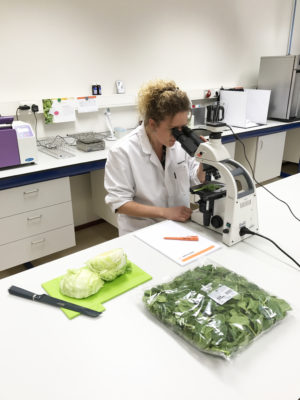FDA, produce industry ramping up leafy greens food safety efforts
Although the U.S. food supply chain is one of the safest in the world, the federal government notes there are still approximately 48 million cases of foodborne illness each year.
As a result, the Food and Drug Administration (FDA) has put great emphasis on improving food safety, especially in produce like leafy greens. This emphasis is due, in part, due to a series of E. coli outbreaks that have sickened consumers and rattled public trust. Several government initiatives aim to reduce incidents, and two equipment manufacturers weigh in on technological advances designed to mitigate pathogen load in leafy green production. Their work is timely.
Prevention, response and addressing knowledge gaps
E. coli outbreaks in leafy greens aren’t new. In fact, between 2009 and 2018, FDA and CDC identified 40 foodborne outbreaks of Shiga toxin-producing E. coli (STEC) infections in the U.S. with a confirmed or suspected link to leafy greens.
While most E. coli strains are harmless, STEC has the potential to cause life-threatening issues, such as bloody diarrhea, anemia, blood-clotting problems and kidney failure.
 Much work has been done to prevent future outbreaks in leafy greens. Under the FDA Food Safety Modernization Act, the Produce Safety Rule (FSMA) sets science-based standards that aim to ensure water, compost, food contact surfaces and other materials that touch produce during growth, harvest, packing, and handling don’t cause contamination. The Produce Safety Rule also addresses worker hygiene and possible infection from animals in nearby fields.
Much work has been done to prevent future outbreaks in leafy greens. Under the FDA Food Safety Modernization Act, the Produce Safety Rule (FSMA) sets science-based standards that aim to ensure water, compost, food contact surfaces and other materials that touch produce during growth, harvest, packing, and handling don’t cause contamination. The Produce Safety Rule also addresses worker hygiene and possible infection from animals in nearby fields.
Specifically, the FDA has developed an action plan that focuses on prevention, response, and addressing knowledge gaps. Under prevention, the FDA focused on advancing agricultural water safety and bolstering inspection, auditing and certification programs.
To further support prevention efforts, FDA is testing samples of romaine lettuce grown in California’s Central Coast, Central Valley and Imperial Valley and in Yuma, Arizona, for pathogenic E. coli and salmonella. They also aim to determine which sampling techniques are most effective in detecting contaminated product at harvest.
In an effort to improve response activities, FDA believes it is critical to share lessons learned in previous outbreaks. As such, FDA agreed to publish an outbreak investigation report that included the trace-back and sampling activities conducted in the Salinas Valley growing region of California.
Following three separate E. coli outbreaks that were linked to leafy greens in the fall of 2019, the FDA, the Centers for Disease Control and Prevention (CDC) and state partners launched an investigation. Authorities traced the strain (STEC E. coli O157:H7) back to romaine lettuce, which was further traced back to the Salinas Valley growing region in California. Results of the investigation suggest that a potential contributing factor was the proximity of cattle to production fields.
FDA also promised to conduct follow-up surveillance during the fall 2020 California growing and harvest season, to promote tech-enabled traceability, and to enhance outbreak and recall communications.
Under addressing knowledge gaps, FDA promised to conduct longitudinal studies. In November of last year, FDA announced the launch of a multi-year longitudinal study to improve food safety through a deeper understanding of the pathogens that cause foodborne illness outbreaks.
“In alignment with the FDA’s New Era of Smarter Food Safety initiative, the findings from this longitudinal study will contribute new knowledge on how various environmental factors may influence bacterial persistence and distribution in the region, and how those factors may impact the contamination of leafy greens,” Frank Yiannas, FDA Deputy Commissioner for Food Policy and Response, said at the time of the announcement.
Equipment manufacturers step up
Prevention, though, goes beyond the field. At the processing level, equipment manufacturers, including Sormac and Kronen, are making strides to mitigate the spread of foodborne pathogens at the processing level.

In a recent internal study, Sormac conducted an investigation to see if UV-C could be used to disinfect wash water. UV-C is ultraviolet light that lies outside of humans’ observable spectrum. Their investigation found that germicidal effect was highest between 240 and 280 nm. At this wavelength, the light disrupts the DNA of microorganisms, inhibiting them from multiplying. The study, which was conducted at pilot-scale first and then larger scale, garnered positive results when UV-C was used correctly.
UV-C disinfection offers processors three possible benefits. It has the capacity to reduce the probability of cross-contamination where pathogens are transferred from one product to another. Because the end product is microbiologically “cleaner,” it’s possible to extend product shelf life. UV-C disinfection may also offer financial savings, as less fresh water is needed in the process.
Processors don’t have time to fuss with hard-to-clean machines. They want to minimize downtime and get sanitation crews to get in and out quickly. To address this concern, Kronen focuses on quick and easy disassembly and re-assembly methods for cleaning.
Speed isn’t always desirable, though, especially in washers designed for leafy greens.
“One of the downsides of most washers is dwell time,” said U.S. sales manager Russell Quandt. “The product has to be in contact with the sanitizing solution for a very strict amount of time, and most washers run too fast for that.”
To address this issue, Kronen designed a new washer for vegetables and leafy greens: GEWA 3800 RT.
The GEWA 3800 RT washer utilizes helical-style water agitation. Instead of running through the washer, the discharge is blocked for a set amount of time so product in the wash tank can be thoroughly agitated and separated, allowing for complete exposure to sanitizer. The timer can be changed to suit customer specifications.
“It takes the guesswork out from having operators decide how long the product’s been in the solution,” said Quandt.
Kronen is also constantly working to upgrade the hygienic design and performance of their washers, he added. They’re doing this by eliminating harboring points, including square corners, steel tube, and wire and cable management systems. They use continuous welds instead of stitch welds, as wall as standoffs to eliminate surface-to-surface connections. All surfaces in the washers are sloped so water cannot pool and sit.
“In the machine industry, it’s easy to make a machine complicated,” Quandt concluded. “It’s more difficult to make them simple, and Kronen has been very good at designing machines that work extremely well with the least amount of parts.”
Kronen works with small to medium-sized processors and customizes equipment to customer specifications.










